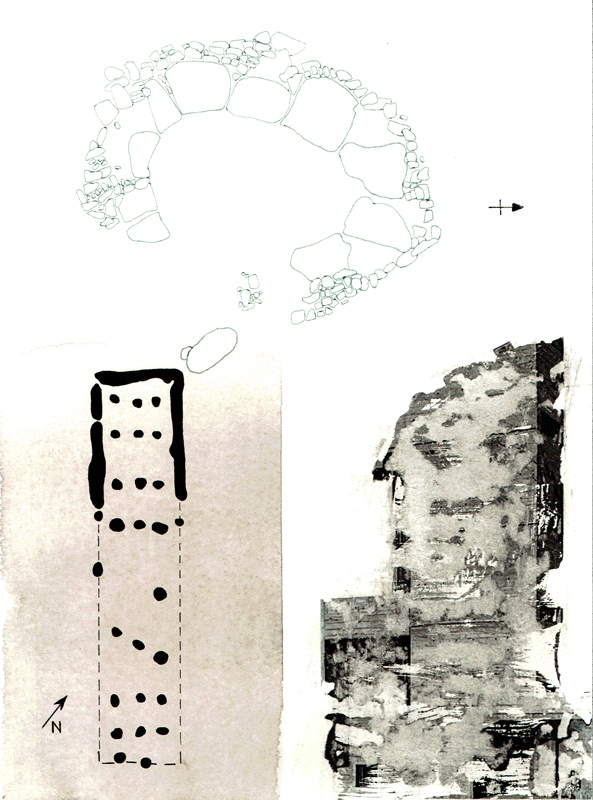[NOTE: see the full, uncropped, version of this work below]
Brutalithic Sequence
Brutalithic Sequence (2017-18) is a series of works that Greg Slick made on paper and which marks a crossroads of art, archaeology, and modernist architecture. By exploring the idea of monumentalism in both Brutalist buildings and Neolithic structures, the series endeavors to link our experience of buildings of authority with that of prehistoric heritage sites (in Britain, Ireland, Scotland, Spain, and Wales) and our cultural roots in the distant past.
Greg first began to align photographic images of Brutalist buildings with drawings of invented Neolithic site plans and elevations during an artist’s residency at the Constance Saltonstall Foundation for the Arts in 2017. The process combined several media (ink drawing, acrylic phototransfer, and gouache) to create multiple layers of imagery, textures, and meaning. The use of monochrome acknowledges the conventions of archaeological drawing as well as the severe palette of Brutalist buildings. The overall effect is that of a fever dream of data and emotions. The idea to juxtapose and create a dialogue between these seemingly disparate sets of imagery came to Greg while he was visiting university museums, a number of which are housed in Brutalist buildings. The backwards and forwards leaps in chronology that I saw in more than one modern concrete temple that contained anthropological artifacts and which was embedded in deep history made sense to Greg: we all remain connected across time.
At the general level of Greg’s wider body of work, he tries to look back in order to look forward. To do this, he investigates the interface of art, archaeology, and anthropology as well as the influence of ancient and “primitive” cultures on contemporary art. Prehistoric stone structures and artifacts, Informalism, the Earth Art movement, and the study of shamanism are some of the key influences on his practice. In many of his paintings and drawings, he references the graphic qualities of Neolithic and Iron Age archaeological surveys and sites within an abstract language. The palette and textures within the works often allude to the rural fields in which dolmens, wedge tombs, cairns, and standing stones are found.
Greg has also begun to investigate the conventions of archaeological fieldwork and museum display. His stone beehive hut sculptures are presented as both scale models one might see in a history museum and as abstract works in their own right. His stone figures and petroglyphs leverage both ancient imagery and 20th century Primitivism while attempting to explore a connection between an authentic experience of the past and a museum-mediated one of the present. All of Greg’s sculptures live within the ambiguous zone between art and archaeological display. His longstanding fascination with the deep past raises questions about what we seem to know (and ultimately don’t know) about our origins.
Greg’s work raises questions about our institutionalized and accepted norms of knowledge concerning prehistory and antiquity, and suggests that in order to understand where our culture of aesthetic objects is headed, we must know from where it has come.
For more information about this and other of Greg’s work, follow this link:
![[NOTE: see the full, uncropped, version of this work below]](https://images.squarespace-cdn.com/content/v1/5c66fe72bfba3e68bbefda77/1564687129659-S3SRSVR6P6ZDI8QHDBDF/image-asset.jpeg)





